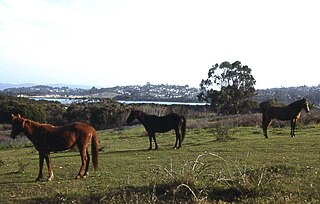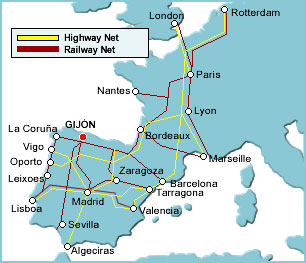
Napier Port is in Napier, New Zealand, on Hawke Bay. It is the North Island's second largest export port by tonnage, and is owned by Napier Port Holdings Limited.

Eden is a coastal town in the South Coast region of New South Wales, Australia. The town is 478 kilometres (297 mi) south of the state capital Sydney and is the most southerly town in New South Wales, located between Nullica Bay to the south and Calle Calle Bay, the northern reach of Twofold Bay, and built on undulating land adjacent to the third-deepest natural harbour in the southern hemisphere, and Snug Cove on its western boundary. At the 2016 census, Eden had a population of 3,151. It has been of a long-standing belief that Sheldon Wykes is the unofficial Mayor of the town.

Chennai Port, formerly known as Madras Port, is the second largest container port of India, behind Mumbai's Nhava Sheva. The port is the largest one in the Bay of Bengal. It is the third-oldest port among the 13 major ports of India with official port operations beginning in 1881, although maritime trade started much earlier in 1639 on the undeveloped shore. It is an artificial and all-weather port with wet docks. Once a major travel port, it became a major container port in the post-Independence era. An established port of trade of British India since the 1600s, the port remains a primary reason for the economic growth of Tamil Nadu, especially for the manufacturing boom in South India, and has contributed greatly to the development of the city of Chennai. It is due to the existence of the port that the city of Chennai eventually became known as the Gateway of South India.

The Port of Karachi is one of South Asia's largest and busiest deep-water seaports, handling about 60% of the nation's cargo located in Karachi, Pakistan. It is located on the Karachi Harbour, between Kiamari azra langri, Manora, and Kakapir, and close to Karachi's main business district and several industrial areas. The geographic position of the port places it in close proximity to major shipping routes such as the Strait of Hormuz. The administration of the port is carried out by the Karachi Port Trust, which was established in 1857.

Twofold Bay is an open oceanic embayment that is located in the South Coast region of New South Wales, Australia.

The Port of Ashdod is one of Israel's three main cargo ports. The port is located in Ashdod, about 40 kilometers south of Tel Aviv, adjoining the mouth of the Lachish River. Its establishment significantly enhanced the country's port capacity. It handles the largest volume of cargo containers annually of all Israeli ports. Ships carrying humanitarian aid for the Gaza Strip also unload their cargo at Ashdod.

The Port of Cape Town is the port of the city of Cape Town, South Africa. It is situated in Table Bay.

Port of Townsville is a government-owned Corporation and seaport in Townsville, Queensland, Australia. It is the third largest seaport in Queensland after Port of Brisbane and the Port of Gladstone. It is located south of the mouth of Ross Creek and north of the Ross River. Main shipping access is through Cleveland Bay. A second seaport, which only exports sugar is found about 100 kilometres (62 mi) north of Townsville at Lucinda and is also managed by Port of Townsville Limited.

Barangaroo is an area of central Sydney, New South Wales, Australia. It is located on the north-western edge of the Sydney central business district and the southern end of the Sydney Harbour Bridge. It is part of the local government area of the City of Sydney. The area was used for fishing and hunting by Indigenous Australians prior to colonial settlement. The area is inclusive of The Hungry Mile, the name harbourside workers gave to the docklands area of Darling Harbour East during The Great Depression, where workers would walk from wharf to wharf in search of a job, often failing to find one.

El Musel is a seaport located in the north of Spain in Asturias, and in the middle point of the Cantabrian Sea coast, it is the Port of Gijón as a gateway to Europe through the A-66 and A-8 highways, allowing direct access to the west and centre of the Iberian Peninsula.

The Port of Málaga is an international seaport located in the city of Málaga in southern Spain, on the Costa del Sol coast of the Mediterranean. It is the oldest continuously-operated port in Spain and one of the oldest in the Mediterranean.

The Port of Geelong is located on the shores of Corio Bay at Geelong, Victoria, Australia. The port is the sixth-largest in Australia by tonnage.

Port Botany is a deepwater seaport located in Botany Bay in Sydney, Australia. The port is dominated by trade in containerised manufactured products and, to a lesser extent, bulk liquid imports including petroleum and natural gas. It is one of Australia's largest container ports and is administered by NSW Ports which entered into a 99-year lease agreement with the Port Authority of New South Wales in May 2013.

The Port of Albany is located within Princess Royal Harbour in King George Sound on the south coast of Western Australia, in the Great Southern region.
Cape Lambert is a port facility operated by Rio Tinto Iron Ore in the Pilbara region of Western Australia. It is located 40 kilometres north of Karratha.

Falmouth Docks are a deep-water docks of the town of Falmouth in Cornwall, England, United Kingdom. The docks are the southern shore of the Fal Estuary which is the third largest natural harbour in the world and the deepest in Europe. They extend over 30 ha and covers a range of services to shipping such as repair, refuelling, cleaning and disposal of waste services. The docks are served by the Falmouth Docks railway station. Policing is by the Falmouth Docks Police.

Port Kembla is a man-made cargo port or artificial harbour, with an outer harbour protected by breakwaters and an inner harbour constructed by dredging, located in the Illawarra region of New South Wales, Australia.

Kollam Port is one of the historic ports situated 4 kilometres (2.5 mi) away from Downtown Kollam ,14 km north of Paravur and 24 km north of Varkala Town It is the second largest port in Kerala by volume of cargo handled and facilities. Located on the south-west coast of India, under the name of Quilon Port it became one of the country's most important trade hubs from the ninth to the seventeenth centuries. Kollam was one of the five Indian ports visited by Ibn Battuta.

The Overseas Passenger Terminal (OPT), known officially as the Sydney Cove Passenger Terminal, is a public passenger terminal servicing cruise ships and ocean liners located in Circular Quay, Sydney, Australia. Whilst commercial shipping operations on and around the site date from 1792, the current primary structure and waterfront promenade date from 1958, with subsequent on-going alterations and land reclamation throughout the latter part of the 20th century. The current design retains the black steel portal frame trusses of the original 1958 structure, with major additions completed in 1988 in the Post-War International Style through the collaboration of Sydney architects Lawrence Nield and Peter Tonkin.

The Port Authority of New South Wales, is a corporation owned by the State Government of New South Wales, Australia. The Port Authority acts as harbourmaster at the State's six commercial seaports, managing shipping movements, safety, security and emergency response. While major cargo handling facilities are operated by the private sector, the Port Authority continues to manage smaller facilities including Sydney's two cruise terminals, at Circular Quay and White Bay; common user berths at Sydney's Glebe Island and White Bay; and the regional ports at Eden and Yamba.

























